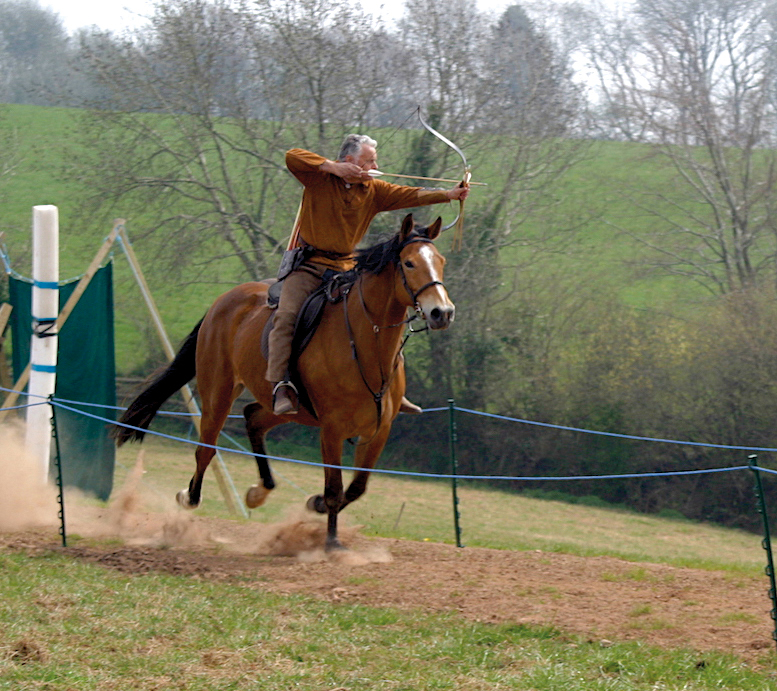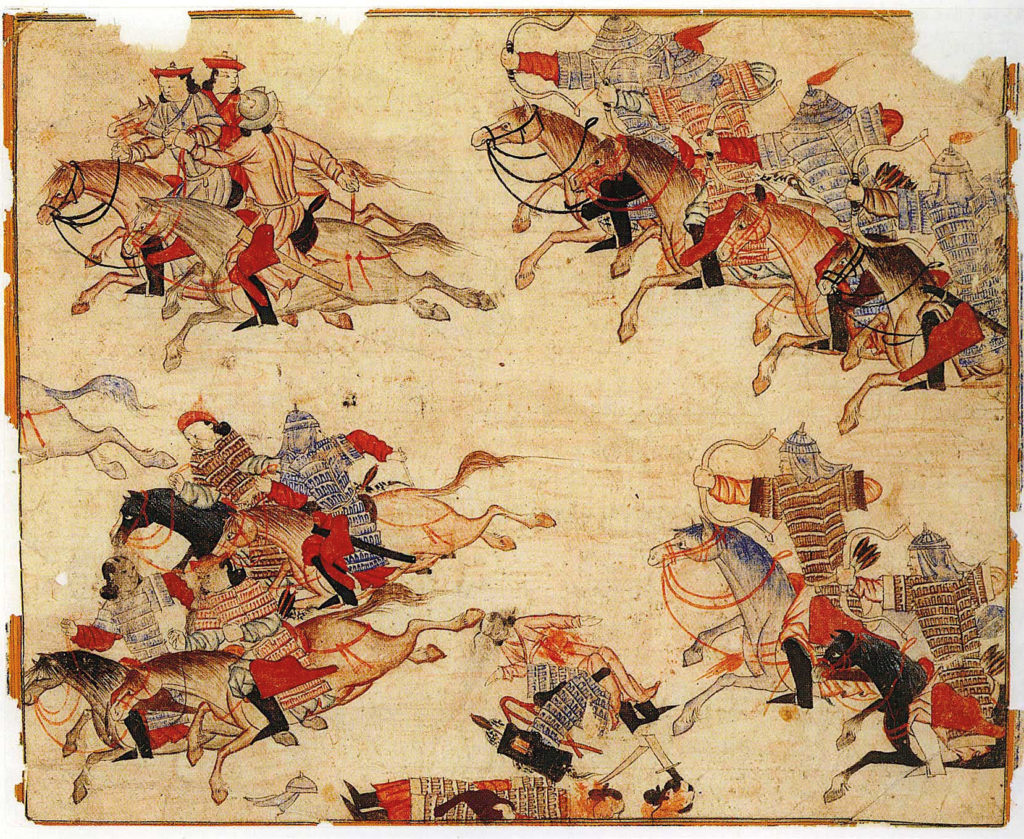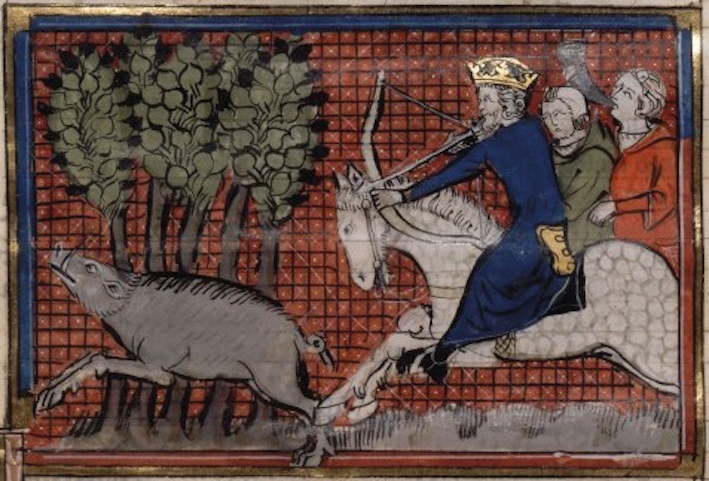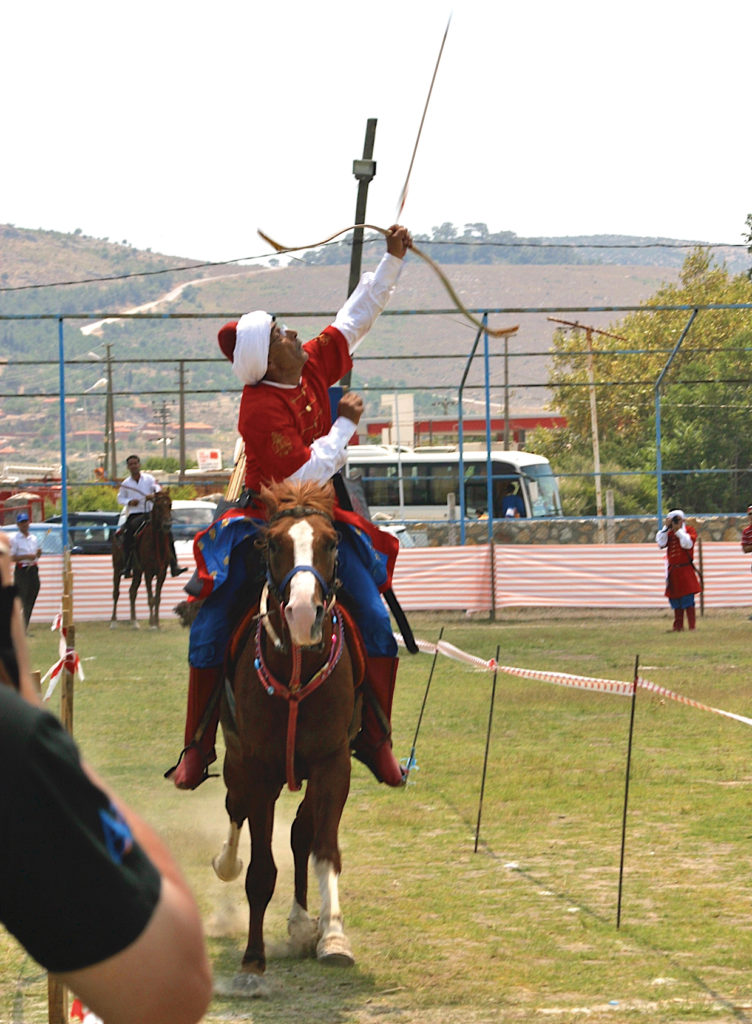Jan H. Sachers M.A takes us on a remarkable journey.

As a modern sport, horseback archery (HBA) is a relatively new phenomenon. But its origins date back many thousands of years, and over the course of history it has been practiced and perfected in many different cultures, producing different styles, different disciplines.
While some of them have survived the centuries in form of tradition or ritual, others are now being rediscovered by eager practitioners around the world.
The roots of horseback archery lie in ancient forms of warfare practiced by mounted warriors. It was the Scythians who first made entire empires tremble with the hoofbeat of their horses and the showers of their arrows.
They inhabited the endless plains of the Eurasian steppe around the Black Sea, and they seemed so united with their steeds that they probably inspired the centaur myth.
In the 5th century BC the Greek historian Herodotus wrote about the Scythians: ‘Having neither cities nor forts, and carrying their dwellings with them wherever they go; accustomed, moreover, one and all of them, to shoot from horseback; and living not by husbandry but on their cattle, their waggons the only houses that they posses, how can they fail of being unconquerable, and unassailable even?‘
Of the Persians, another ancient people famous for its mounted archers, it was later said that they taught their sons only three things: to ride, to shoot with bow and arrow, and to always speak the truth.
The Sarmatians in the area of todays Iran, the Parthians and Sassanids, the Avars and Alans were also known and feared as horseback archers, and many of them served in the armies of Rome.
In the 4th and 5th centuries AD the mounted archers of the Huns were feared throughout Europe as the ‘Scourge of God‘, and ‘Lord, deliver us from the arrows of the Hungarians‘ was a common enough prayer in the 9th century.
Mongols
The most successful of these peoples from the Eurasians steppes however were the Mongols. From the backs of their small, but sturdy ponies they conquered not only vast parts of Asia between the Mediterranean coast and China, but also advanced west as far as Hungary and Poland, before they returned home in 1241, their mighty empire slowly falling victim to internal disputes.
Medieval European armies struggled with the nomad way of fighting. Small bands of mounted archers cantered towards them, passing their front line, loosing arrow after arrow at armoured knights and infantry alike, before circling back to the main body.

They were fast and highly mobile, manoeuvring their horses solely with their legs – making use of the stirrup, said to be invented by the Huns, which was adapted only slowly by Western riders during the Middle Ages.
Another common factor among the steppe peoples was the type of bow they used: It was the short, reflex composite bow, laminated from layers of horn and sinew on a wooden core.
Differences in design reflect cultural preferences as well as availability of materials, and innovations in bow construction such as the V-splice, not so much an evolution in bow design.
Even the earliest examples, the Scythian composite bows, were of extraordinary power, and enabled a long draw despite their shortness.
Japan and the east
Many modern bows copy these old designs, using artificial materials like fibreglass and carbon, and are marketed as ’horse bows‘, which is a silly name, since every bow can be, and has been, used on horseback – even the extra-long Japanese yumi.
This 2.25 m long Bamboo-composite bow is built asymmetrically, with the bottom end being considerably shorter, so it does not get in the way of the horse.
While Kyudo, the Japanese art of archery, has long found its way into the West, Japanese horseback archery or Yabusame is not yet equally well known outside its homeland. It is a spectacle with traditions dating back hundreds of years, and mainly associated with certain religious holidays.
In Yabusame, three rather small painted wooden targets are set up along a 255 m long track. The arrows, which are equipped with a heavy wooden head and V-shaped iron tip, are shot from full canter and make the targets burst with a loud bang when hit.
Jinba Ittai, ’horse and rider are one‘, is the ideal of this discipline, that qualifies more as a ritual than as a sport. The events are part of elaborate ceremonies, the archers are clad in colourful traditional garb, and follow a strict protocol.
Mounted archery has played an important role in many cultures, sometimes up into modern times. In Korea, the tradition of Mogu originated as a means to practice the hunt from horseback. One rider has a huge ball on a string attached to his horse. He is given a certain lead before two or four mounted archers chase after him, trying to hit the madly jumping target with blunt arrows.
In the Turkish Qabaq game (literally: ‘gourd‘) the target is mounted on top of an eight to twelve metres high pole. It was very popular throughout the Ottoman empire, and even sultans like the famous Murad II were keen to show their archery prowess in this discipline.
Archers were usually divided into two teams taking turns cantering along a track and trying to hit the target from below, shooting straight up while twisting their bodies down and back in the waist.
Around the world
The Habsburg emperor Maximilian I (1459-1519), ‘the last knight‘, favoured bow-hunting from horseback, and many other regents and rulers in East and West throughout history shared his taste. Byzantine emperor John II Komnenos (1118-1143) even found his unfortunate end while chasing after a boar.
three sections of equal length, the three targets at its centre facing three different directions. In the first section, the archers shoot forward, in the second to their left, and in the final section they turn backwards as if shooting at a pursuer.

Shooting backwards while riding forward: this far-from-easy task is known as the ’parting shot‘, although it was originally called the ‘Parthian shot‘, after the mounted warriors of antiquity who were said to be masters of this technique.
On the Korean track one, two, or five targets are set up to the left of the rider, with their centre 1m above the ground. The track is 90 or 150 m long, and has to be finished, and all targets shot at, within 12 or 15 seconds.
Various other disciplines are being practiced in different countries, and new ones developed all the time, even tracks with jumps and other obstacles, or 3D archery on horseback on cross-country courses.
Advanced riding skills are a prerequisite in all forms of horseback archery. When handling bow and arrow, there is no hand left to hold the reins, and the rider has to be able to command his horse with his weight and legs alone.
In a canter, there is a short phase when all the horse‘s four hoofs are off the ground. This is the ideal time for arrow release, while the rider straightens up in the saddle. The next arrow has to be pulled out of the quiver and put on the string without taking the eyes off the next target.

The motions of the horse make the usual systems of aiming obsolete, and the limited time requires each shot to be performed in one smooth, fluid motion with a ‘floating‘ anchor.
All breeds of horses are suited for horseback archery, but the horse has to be specially trained, so as not to spook when the rider is handling pointy objects within its field of vision.
The twang of the string and the sudden rapid movement of a projectile can easily result in panic reaction in unconditioned horses! So the mount has to be taken through a process of careful training and conditioning to learn that there is no danger in whatever the rider does on its back – and it is the responsibility of the horseback archer to make sure it is so.
Nowadays, there are HBA associations to be found in most European countries as well as in the US, to help people start their journey in this fascinating sport.
Horseback archery today
The World Horseback Archery Federation (WHAF) is the international association of mounted archers recognised by the UNESCO.
Several national and international competitions are now held regularly, comprising of different disciplines like Hungarian and Korean targets, Mogu, Qabaq, and others, each one fast and thrilling, and a sight you don‘t see everyday.
If you‘re interested, check for EOCHA, the European Open Championships of Horseback Archery, or the al-Faris competition in Jordan under the royal patronage of King Abdullah II ibn Al-Hussein.
All of them, and many others throughout the world, help keeping the international traditions of horseback archery alive, and develop it into a sport of the future.


Would you be able to provide the names or sources of the manuscripts referenced, particularly the 14th century manuscripts that references the Mongols? Thank you!